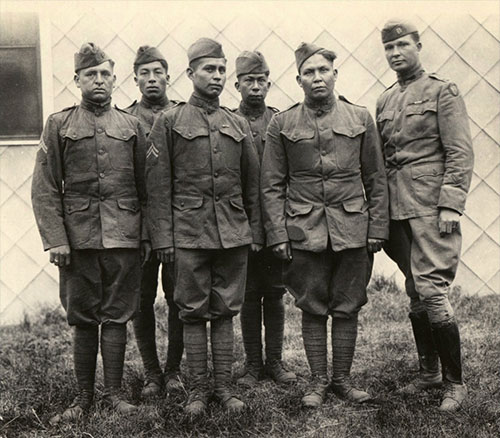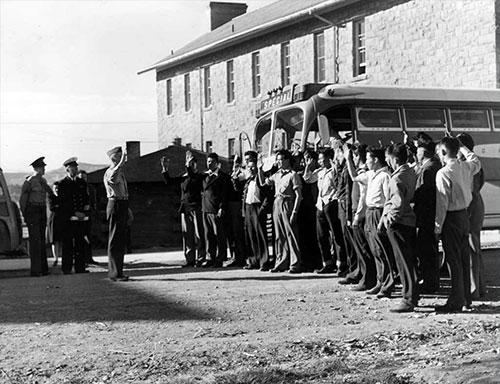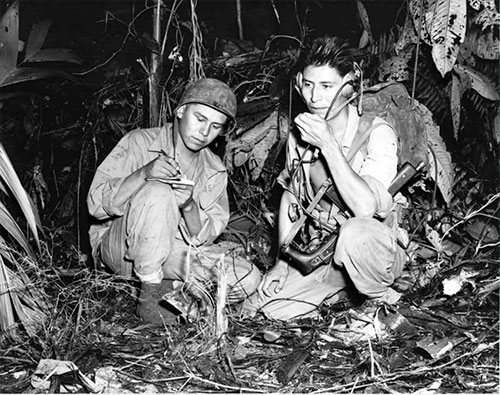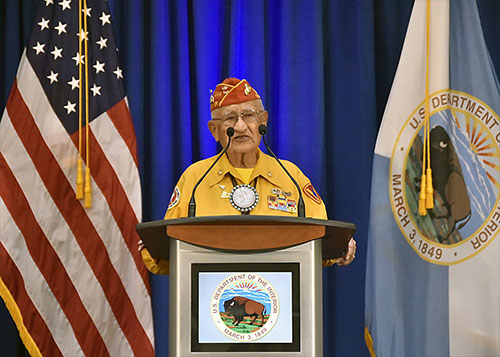
Honoring America's Veterans: Native American Code Talkers
November 11, 2017
During times of war, secure communications can mean the difference between life and death; victory and defeat. In World War I and World War II, the United States military relied on a unique series of codes to keep its messages safe from the enemy. These codes weren’t based on cutting-edge technology or complex mathematical equations, though. Finding their origins in Native American languages, these codes were spoken by a brave group of men recruited from tribal communities across the country. Those men became known as Code Talkers.
In World War I, soldiers of Native American descent, mostly Choctaw, used their tribal languages to transmit messages by telephone. Though not used extensively, the actions of these men confused the Germans and helped win several battles in France. Approximately 12,000 Native Americans served in the military during World War I. When the United States entered World War II, the military again called on Native Americans to be Code Talkers. Fearing that some of the previously used languages may have been studied by the Germans and Japanese between the wars, military leaders looked for a new code that was more complex. For the U.S. Marine Corps, the Navajo language quickly became the answer. It isn’t a written language and very few people not of Navajo origin understood it. In 1942, the Marine Corps began recruiting and training Navajo men to be Code Talkers. Carl Gorman was one of the first Navajo to join up. “For us, everything is memory, it’s part of our heritage. We have no written language. Our songs, our prayers, our stories, they’re all handed down from grandfather to father to children -- and we listen, we hear, we learn to remember everything. It’s part of our training.” The first 29 Navajo Code Talkers created an phonic alphabet and used word substitution to develop an all but unbreakable code. “Fighter plane” became “hummingbird.” “Turtle” became “tank.” “”Battleship” became “whale.”
Other branches of the military recruited Native Americans from the Assiniboine, Cherokee, Cheyenne, Chippewa, Choctaw, Comanche, Cree, Crow, Hopi, Kiowa, Menominee, Meskwaki, Mississauga, Muscogee, Osage, Pawnee, Sac and Fox, Seminole and Sioux tribes to create similar military codes based on their own languages. After the codes were established, trained Code Talkers joined combat units around the world. The Navajo and Hopi were assigned to service in the Pacific. Comanches fought the Germans in Europe, and the Meskwakis fought them in North Africa. Code Talkers from other tribes fought at various locations in Europe, the Pacific, North Africa and elsewhere. Because the code was considered to be so important, many Code Talkers were assigned guards and weren’t allowed to move around alone.
Fighting in the battles of Guadalcanal, Tarawa, Tinian, Saipan and the D-Day invasion of Normandy, Code Talkers saved lives by signaling enemy movements, transmitting orders and coordinating attacks under fire. Major Howard Cooper, a signal officer commanding Code Talkers, said “Were it not for the Navajos, the Marines would never have taken Iwo Jima.” The Code Talkers were proud of their accomplishments in combat and communications. Navajo Thomas Begay would later say about the codes, “It means a lot to me. Nobody -- Japanese, no one -- ever decoded it.”
Despite earning the respect of their fellow soldiers and marines, Code Talkers received no recognition on the home front. Their code and actions remained classified until 1968. As their role in the war became better known, Code Talkers have been celebrated in movies and television shows, and many have been awarded medals from Presidents and Congress. Combining the wisdom and warrior tradition of their tribes with modern day technology and tactics, Code Talkers earned their place as American heroes. Over 44,000 Native Americans served between 1941 and 1945. The entire population of Native Americans in the United States was less than 350,000 at the time. Alaska Natives were a significant presence on the Alaska Combat Intelligence Detachment. This outfit was the first ashore on each island occupied by Allied forces in the Aleutian Campaign. Approximately 10,000 Native Americans served in the military during the Korean conflict. More than 42,000 Native Americans served in the military in the Vietnam Era, and over 90 percent of these Servicemembers were volunteers. Overall In 2016, according to the U.S. Census Bureau's Community Survey, overall there are 18.5 military veterans in the United States. 7.1 million served during the Gulf War from August 1990 to the present. In 2016, there were 4.0 million veterans with a service-connected disability rating in 2016. Of this number, 1.3 million had a rating of 70.0 percent or higher. A “service-connected” disability is one that was a result of a disease or injury incurred or aggravated during active military service. Severity of one’s disability is scaled from 0.0 to 100.0 percent, and eligibility for compensation depends on one’s rating. In the 2016 election, 69.6 percent of veterans cast a ballot, compared with 60.6 percent of nonveterans. These rates reflect the citizen voting-age population. There are 398,453 U.S. employer firms that are majority owned by veterans. Veteran-owned firms comprised only 7.2 percent of the nation's 5.5 million employer businesses. The number of living veterans in 2016 who served during three wartime periods:
The number of living veterans in 2016 who served during two wartime periods:
For 98 years, Americans have remembered those who served our country in uniform on 11 November – first as Armistice Day, and then, since 1954 as Veterans Day. In this 99th year of commemoration, the Department of Veterans Affairs is broadening that tradition of observance and appreciation to include both Veterans and Military Families for the entire month of November. Veterans Day originated as “Armistice Day” on Nov. 11, 1919, the first anniversary marking the end of World War I. Congress passed a resolution in 1926 for an annual observance, and Nov. 11 became a national holiday beginning in 1938. President Dwight D. Eisenhower signed legislation in 1954 to change the name to Veterans Day as a way to honor those who served in all American wars. The day honors military veterans with parades and speeches across the nation and a remembrance ceremony takes place at the Tomb of the Unknowns at Arlington National Cemetery in Arlington, Va. The ceremony is to honor and express gratitude to all who served in the U.S. armed forces.
Editing by Mary Kauffman, SitNews
Source of News:
Representations of fact and opinions in comments posted are solely those of the individual posters and do not represent the opinions of Sitnews.
|
||||||



